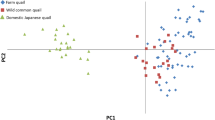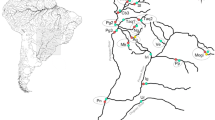Abstract
Many cases of introgressive hybridization have been reported among birds, particularly following introduction to the natural environment of individuals belonging to non-native similar taxa. This appears to be the case for common quail (Coturnix coturnix) in France where wild populations artificially come into contact with domesticated Japanese quail (Coturnix japonica) raised for meat and egg production but sometimes released for hunting purposes. In order to highlight the possible existence of gene flows between both taxa, a comparison of nuclear (25 microsatellite loci) and mitochondrial (sequencing and RFLP) DNA polymorphisms was performed on 375 common quails (from France, Spain and Morocco) and 140 Japanese quails (from France and Japan). Genetic diversity was assessed, and analyses (Factorial Correspondence Analysis, Bayesian admixture) of molecular polymorphisms revealed clear differentiation between the two taxa, making it possible to detect for hybrids among quails sampled in the wild. Eight birds expected to be common quail were found to be two pure Japanese quail, one probable backcross to C. japonica, three F1/F2 hybrids, and two probable backcrosses to Coturnix coturnix. These results show that Japanese quails were released and suggest that the two taxa hybridize in the wild. They confirm the urgent need for preventing the release of pure Japanese or hybrid quails to preserve the genetic integrity of C. coturnix. The tools developed for this study should be useful for accurate monitoring of wild quail populations within the framework of avifauna management programs.



Similar content being viewed by others
References
Allendorf FW, Leary RF, Spruell P, Wenburg JK (2001) The problems with hybrids: setting conservation guidelines. Trends Ecol Evol 16:613–622. doi:10.1016/S0169-5347(01)02290-X
Andersson M (1999) Hybridization and skua phylogeny. Proc R Soc Lond 266:1579–1585. doi:10.1098/rspb.1999.0818
Andreotti A, Baccetti N, Perfetti A, Besa M, Genovesi P, Guberti V (2001) Mammiferi e Uccelli esotici in Italia: analisi del fenomeno, impatto sulla biodiversità e linee guida gestionali. Quad Conservazione Natura 2:1–189
Arnold ML (1997) Natural hybridization and evolution. Oxford University Press, New York
Arnold ML (2004) Natural hybridization and the evolution of domesticated, pest and disease organisms. Mol Ecol 13:997–1007. doi:10.1111/j.1365-294X.2004.02145.x
Avise JC (1994) Molecular markers, natural history and evolution. Chapman & hall, New York
Baratti M, Ammannati M, Magnelli C, Dessi-Fulgheri F (2005) Introgression of chukar genes into a reintroduced red-legged partridge (Alectoris rufa) population in central Italy. Anim Genet 36:29–35. doi:10.1111/j.1365-2052.2004.01219.x
Barilani M, Derégnaucourt S, Gallego S, Galli L, Mucci N, Piombo R, Puigcerver M, Rimondi S, Rodríguez-Teijeiro JD, Spanò S, Randi E (2005) Detecting hybridization in wild (Coturnix c. coturnix) and domesticated (Coturnix c. japonica) quail populations. Biol Conserv 126:445–455. doi:10.1016/j.biocon.2005.06.027
Barton NH (2001) The role of hybridization in evolution. Mol Ecol 10:551–568. doi:10.1046/j.1365-294x.2001.01216.x
Barton NH, Hewitt GM (1989) Adaptation, speciation and hybrid zones. Nature 341:497–503. doi:10.1038/341497a0
Belkhir K, Borsa P, Chikhi L, Raufaste N, Bonhomme F (1996-2004) GENETIX 4.05, logiciel sous Windows TM pour la génétique des populations. Laboratoire Génome, Populations, Interactions, CNRS UMR 5171, University Montpellier II, Montpellier, France
Bernatchez L, Savard L, Dodson JJ, Pallotta D (1988) Mitochondrial DNA sequence heterogeneity among James-Hudson Bay anadromous coregonines. Finn Fish Res 9:17–26
BirdLife International (2004) State of the world’s birds 2004: indicators for our changing planet. BirdLife International, Cambridge
Boecklen WJ, Howard DJ (1997) Genetic analysis of hybrid zones: numbers of markers and power of resolution. Ecology 78:2611–2616
Boutin J-M (1999) Analyse des ailes de cailles des blés prélevées dans le département des Hautes-Pyrénées. Synthèse de 1997 à 1999. Internal Report, ONC, Chizé, France
Chang CM, Coville JL, Coquerelle G, Gourichon D, Oulmouden A, Tixier-Boichard M (2006) Complete association between a retroviral insertion in the tyrosinase gene and the recessive white mutation in chickens. BMC Genomics 7:19. doi:10.1186/1471-2164-7-19
Chazara O, Lumineau S, Minvielle F, Roux D, Feve K, Kayang B, Boutin J-M, Vignal A, Coville J-L, Rognon X (2006) Etude des risques d’introgression génétique de la caille des blés (Coturnix coturnix coturnix) par la caille japonaise (C. c. japonica): comparaison et intégration des données comportementales et moléculaires obtenues dans le sud-est de la France. Les Actes du BRG 6-6e colloque national 317–334
del Hoyo J, Elliott A, Sargatal J (1992) Handbook of the Birds of the World, vol 2: New World Vultures to Guinea Fowl. Lynx Edicions, Barcelona, Spain
Derégnaucourt S, Guyomarc’h J-C (2003) Mating call discrimination in female European (Coturnix c. coturnix) and Japanese quail (Coturnix c. japonica). Ethology 109:107–119. doi:10.1046/j.1439-0310.2003.00854.x
Derégnaucourt S, Guyomarc’h J-C, Richard V (2001) Classification of hybrid crows in quail using artificial neural networks. Behav Processes 56:103–112. doi:10.1016/S0376-6357(01)00188-7
Derégnaucourt S, Guyomarc’h J-C, Spano S (2005) Behavioural evidence of hybridization (Japanese x European) in domestic quail released as game birds. Appl Anim Behav Sci 94:303–318. doi:10.1016/j.applanim.2005.03.002
Desjardins P, Morais R (1991) Nucleotide sequence and evolution of coding and noncoding regions of a quail mitochondrial genome. J Mol Evol 32:153–161. doi:10.1007/BF02515387
Evanno G, Regnaut S, Goudet J (2005) Detecting the number of clusters of individuals using the software STRUCTURE: a simulation study. Mol Ecol 14:2611–2620. doi:10.1111/j.1365-294X.2005.02553.x
Fumihito A, Miyake T, Sumi SI, Takada M, Ohno S, Kondo N (1994) One subspecies of the red junglefowl (Gallus gallus gallus) suffices as the matriarchic ancestor of all domestic breeds. Proc Natl Acad Sci USA 91:12505–12509. doi:10.1073/pnas.91.26.12505
Grant PR, Grant BR (1992) Hybridization of bird species. Sciences (New York) 256:193–197
Guyomarc’h J-C (2003) Elements for a common quail (Coturnix c. coturnix) management plan. Game Wildl Sci 20:1–92
Guyomarc’h J-C, Combreau O, Puigcerver M, Fontoura P, Aebischer N (1998) Coturnix coturnix quail. BWP Update 2:27–46
Hall TA (1999) BioEdit: a user-friendly biological sequence alignment editor and analysis program for Windows 95/98/NT. Nucleic Acids Symp Ser 41:95–98
Johnsgard PA (1988) The quails, partridges, and francolins of the world. Oxford University Press, Oxford
Kayang BB, Fillon V, Inoue-Murayama M, Miwa M, Leroux S, Fève K, Monvoisin J-L, Pitel F, Vignoles M, Mouilhayrat C, Beaumont C, Ito S, Minvielle F, Vignal A (2006) Integrated maps in quail (Coturnix japonica) confirm the high degree of synteny conservation with chicken (Gallus gallus) despite 35 million years of divergence. BMC Genomics 7:101. doi:10.1186/1471-2164-7-101
Kumar S, Tamura K, Nei M (2004) MEGA3: integrated software for molecular evolutionary genetics analysis and sequence alignment. Brief Bioinform 5:150–163. doi:10.1093/bib/5.2.150
Martinsen GD, Whitham TG, Turek RJ, Keim P (2001) Hybrid populations selectively filter gene introgression between species. Evolution Int J org Evolution 55:1325–1335
McGinnity P, Prödöhl P, Ferguson A, Hynes R, Maoiléidigh NO, Baker N, Cotter D, O’Hea B, Cooke D, Rogan G, Taggart J, Cross T (2003) Fitness reduction and potential extinction of wild populations of Atlantic salmon, Salmo salar, as a result of interactions with escaped farm salmon. Proc Biol Sci 270:2443–2450. doi:10.1098/rspb.2003.2520
Minvielle F (2004) The future of Japanese quail for research and production. Worlds Poult Sci J 60:500–507. doi:10.1079/WPS200433
Minvielle F, Coville JL, Krupa A, Monvoisin JL, Maeda Y, Okamoto S (2000) Genetic similarity and relationships of DNA fingerprints with performance and with heterosis in Japanese quail lines from two origins and under reciprocal recurrent or within-line selection for early egg production. Genet Sel Evol 32:289–302. doi:10.1051/gse:2000119
Minvielle F, Moussu C, Rognon X, Lumineau S, Gourichon D (2006) Development of an experimental hybrid quail population (Coturnix japonica x Coturnix coturnix): the F2 generation. In: Proceedings of the 8th World Congress on Genetics Applied to Livestock Production, Belo Horizonte, Brazil
Munoz-Fuentes V, Vila C, Green AJ, Negro JJ, Sorenson MD (2007) Hybridization between white-headed ducks and introduced ruddy ducks in Spain. Mol Ecol 16:629–638. doi:10.1111/j.1365-294X.2006.03170.x
Nishibori M, Hayashi T, Tsudzuki M, Yamamoto Y, Yasue H (2001) Complete sequence of the Japanese quail (Coturnix japonica) mitochondrial genome and its genetic relationship with related species. Anim Genet 32:380–385. doi:10.1046/j.1365-2052.2001.00795.x
Pritchard JK, Stephens M, Donnelly P (2000) Inference of population structure using multilocus genotype data. Genetics 155:945–959
Puigcerver M, Vinyoles D, Rodríguez-Teijeiro JD (2007) Does restocking with Japanese quail or hybrids affect native populations of common quail Coturnix coturnix?. Biol Conserv 136:628–635. doi:10.1016/j.biocon.2007.01.007
Randi E, Bernard-Laurent A (1999) Population genetics of a hybrid zone between the red-legged partridge and rock partridge. Auk 116:324–337
Raufaste N, Orth A, Belkhir K, Senet D, Smadja C, Baird SJE, Bonhomme F, Dod B, Boursot P (2005) Inferences of selection and migration in the Danish house mouse hybrid zone. Biol J Linn Soc Lond 84:593–616. doi:10.1111/j.1095-8312.2005.00457.x
Rhymer JM, Simberloff D (1996) Extinction by hybridization and introgression. Annu Rev Ecol Syst 27:83–109. doi:10.1146/annurev.ecolsys.27.1.83
Rognon X, Guyomard R (2003) Large extent of mitochondrial DNA transfer from Oreochromis aureus to O. niloticus in West Africa. Mol Ecol 12:435–445. doi:10.1046/j.1365-294X.2003.01739.x
Rozen S, Skaletsky HJ (2000) Primer3 on the WWW for general users and for biologist programmers. In: Krawetz S, Misener S (eds) Bioinformatics methods and protocols: methods in molecular biology. Humana Press, Totowa, pp 365–386
Staden R, Beal KF, Bonfield JK (2000) The Staden package, 1998. Methods Mol Biol 132:115–130
Tamura K, Nei M (1993) Estimation of the number of nucleotide substitutions in the control region of mitochondrial DNA in humans and chimpanzees. Mol Biol Evol 10:512–526
Vähä JP, Primmer CR (2006) Efficiency of model-based Bayesian methods for detecting hybrid individuals under different hybridization scenarios and with different numbers of loci. Mol Ecol 15:63–72. doi:10.1111/j.1365-294X.2005.02773.x
Acknowledgments
We would like to thank the national network « migrating birds » of the ONCFS, the French National Federation of Hunters, M Maghnouj (Centre de Recherche Forestière, Haut Commissariat aux Eaux et Forêts et à la Lutte contre la Désertification, Rabat, Maroc), Drs K Nirasawa, M Odai and M Minezawa (National Institute of Livestock and Grassland Science, Tsukuba, Japan), the quail breeding company Caillor, Profs M Inoue-Murayama (Kyoto University, Kyoto, Japan) and S Ito (Gifu University, Gifu, Japan), and M Rivière for their cooperation in obtaining samples. We also thank W Brandt-Williams (INRA) for critical reading of the manuscript and the anonymous referees for many valuable suggestions. This research was funded by a grant from the Bureau des Ressources Génétiques (BRG).
Author information
Authors and Affiliations
Corresponding author
Electronic supplementary material
Below is the link to the electronic supplementary material.
Rights and permissions
About this article
Cite this article
Chazara, O., Minvielle, F., Roux, D. et al. Evidence for introgressive hybridization of wild common quail (Coturnix coturnix) by domesticated Japanese quail (Coturnix japonica) in France. Conserv Genet 11, 1051–1062 (2010). https://doi.org/10.1007/s10592-009-9951-8
Received:
Accepted:
Published:
Issue Date:
DOI: https://doi.org/10.1007/s10592-009-9951-8




